|
孙静生
孙静生先生,天津人。 北京辅仁大学英文系毕业。我们班的泛读教授之一。 后调到公共外语教学部任主任。
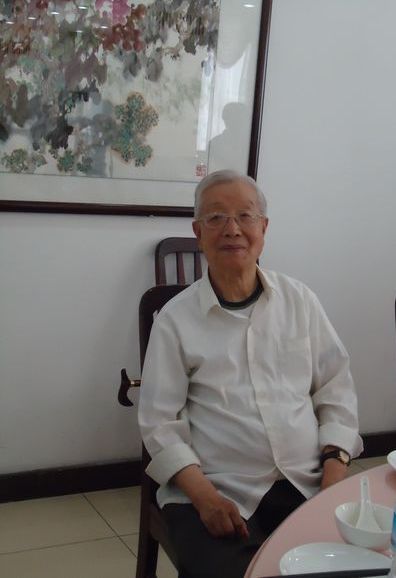
孙老师在65届师生纪念入学50周年的餐会上,6/2010
|
Englis Poet William Blake (1757-1827) |
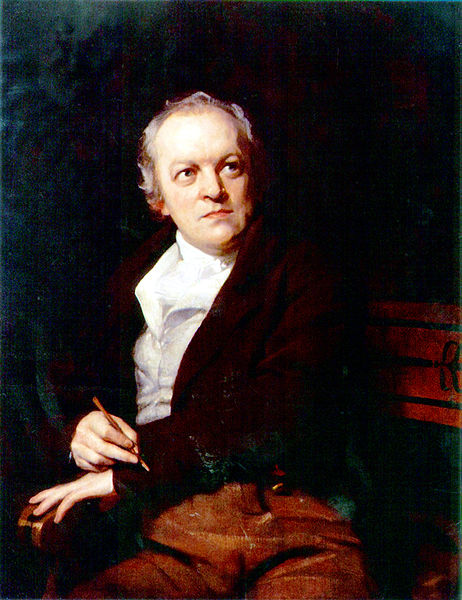
Portrait of William Blake by Thomas Phillips, painted in 1807.
(This work of art is in public domain.)
William Blake was an English poet, painter, and printmaker. He was born in 28A Broad Street, Golden Square, London, England on 28 November 1757, to a middle-class family. He was the third of 7 children, two of whom died in infancy. Blake's father, James, was a hosier. William never attended school, and was educated at home by his mother. The Blakes were Dissenters, and are believed to have belonged to the Moravian Church. The Bible was an early and profound influence on Blake, and would remain a source of inspiration throughout his life.
Largely unrecognised during his lifetime,Blake is now considered a seminal figure in the history of both the poetry and visual arts of the Romantic Age. His prophetic poetry has been said to form "what is in proportion to its merits the least read body of poetry in the English language". His visual artistry has led one modern critic to proclaim him "far and away the greatest artist Britain has ever produced". Although he only once journeyed farther than a day's walk outside London during his lifetime, he produced a diverse and symbolically rich corpus, which embraced 'imagination' as "the body of God", or "Human existence itself".
Considered mad by contemporaries for his idiosyncratic views, Blake is held in high regard by later critics for his expressiveness and creativity, and for the philosophical and mystical undercurrents within his work. His paintings and poetry have been characterized as part of both the Romantic movement and "Pre-Romantic", for its large appearance in the 18th century. Reverent of the Bible but hostile to the Church of England, Blake was influenced by the ideals and ambitions of the French and American revolutions, as well as by such thinkers as Jacob Boehme and Emanuel Swedenborg.Despite these known influences, the singularity of Blake's work makes him difficult to classify. The 19th century scholar William Rossetti characterised Blake as a "glorious luminary," and as "a man not forestalled by predecessors, nor to be classed with contemporaries, nor to be replaced by known or readily surmisable successors."
Blake's marriage to Catherine remained a close and devoted one until his death. Blake taught Catherine to write, and she helped him to colour his printed poems.Gilchrist refers to "stormy times" in the early years of the marriage. Some biographers have suggested that Blake tried to bring a concubine into the marriage bed in accordance with the beliefs of the Swedenborgian Society, but other scholars have dismissed these theories as conjecture. William and Catherine's first daughter and last child might be Thel described in The Book of Thel who was conceived as dead. On the day of his death, Blake worked relentlessly on his Dante series. Eventually, it is reported, he ceased working and turned to his wife, who was in tears by his bedside. Beholding her, Blake is said to have cried, "Stay Kate! Keep just as you are – I will draw your portrait – for you have ever been an angel to me." Having completed this portrait (now lost), Blake laid down his tools and began to sing hymns and verses. At six that evening, after promising his wife that he would be with her always, Blake died. Gilchrist reports that a female lodger in the same house, present at his expiration, said, "I have been at the death, not of a man, but of a blessed angel." |
THE TIGER
by William Blake
- TIGER, tiger, burning bright
- In the forests of the night,
- What immortal hand or eye
- Could frame thy fearful symmetry?
-
- In what distant deeps or skies
- Burnt the fire of thine eyes?
- On what wings dare he aspire?
- What the hand dare seize the fire?
-
- And what shoulder and what art
- Could twist the sinews of thy heart?
- And, when thy heart began to beat,
- What dread hand and what dread feet?
-
- What the hammer? What the chain?
- In what furnace was thy brain?
- What the anvil? What dread grasp
- Dare its deadly terrors clasp?
-
- When the stars threw down their spears,
- And water'd heaven with their tears,
- Did He smile His work to see?
- Did He who made the lamb make thee?
-
- Tiger, tiger, burning bright
- In the forests of the night,
- What immortal hand or eye
- Dare frame thy fearful symmetry?
|
CRADLE SONG
by William Blake
-
SLEEP, sleep, beauty bright,
-
Dreaming in the joys of night;
-
Sleep, sleep; in thy sleep
-
Little sorrows sit and weep.
-
-
Sweet babe, in thy face
-
Soft desires I can trace,
-
Secret joys and secret smiles,
-
Little pretty infant wiles.
-
-
As thy softest limbs I feel,
-
Smiles as of the morning steal
-
O'er thy cheek, and o'er thy breast
-
Where thy little heart doth rest.
-
-
O the cunning wiles that creep
-
In thy little heart asleep!
-
When thy little heart doth wake,
-
Then the dreadful night shall break.
|
THE LITTLE BLACK BOY
by William Blake
-
MY mother bore me in the southern wild,
-
And I am black, but O, my soul is white!
-
White as an angel is the English child,
-
But I am black, as if bereaved of light.
-
-
My mother taught me underneath a tree,
-
And, sitting down before the heat of day,
-
She took me on her lap and kissèd me,
-
And, pointing to the East, began to say:
-
-
'Look at the rising sun: there God does live,
-
And gives His light, and gives His heat away,
-
And flowers and trees and beasts and men receive
-
Comfort in morning, joy in the noonday.
-
-
'And we are put on earth a little space,
-
That we may learn to bear the beams of love;
-
And these black bodies and this sunburnt face
-
Are but a cloud, and like a shady grove.
-
-
'For when our souls have learn'd the heat to bear,
-
The cloud will vanish, we shall hear His voice,
-
Saying, "Come out from the grove, my love and care,
-
And round my golden tent like lambs rejoice."'
-
-
Thus did my mother say, and kissèd me,
-
And thus I say to little English boy.
-
When I from black and he from white cloud free,
-
And round the tent of God like lambs we joy,
-
-
I'll shade him from the heat till he can bear
-
To lean in joy upon our Father's knee;
-
And then I'll stand and stroke his silver hair,
-
And be like him, and he will then love me.
|
NIGHT
by William Blake
-
THE sun descending in the west,
-
The evening star does shine;
-
The birds are silent in their nest.
-
And I must seek for mine.
-
The moon, like a flower
-
In heaven's high bower,
-
With silent delight
-
Sits and smiles on the night.
-
-
Farewell, green fields and happy grove,
-
Where flocks have took delight:
-
Where lambs have nibbled, silent move
-
The feet of angels bright;
-
Unseen they pour blessing
-
And joy without ceasing
-
On each bud and blossom,
-
On each sleeping bosom.
-
-
They look in every thoughtless nest
-
Where birds are cover'd warm;
-
They visit caves of every beast,
-
to keep them all from harm:
-
If they see any weeping
-
That should have been sleeping,
-
They pour sleep on their head,
-
And sit down by their bed.
-
-
When wolves and tigers howl for prey,
-
They pitying stand and weep,
-
Seeking to drive their thirst away
-
And keep them from the sheep.
-
But, if they rush dreadful,
-
The angels, most heedful,
-
Receive each mild spirit,
-
New worlds to inherit.
-
-
And there the lion's ruddy eyes
-
Shall flow with tears of gold:
-
And pitying the tender cries,
-
And walking round the fold:
-
Saying, 'Wrath by His meekness,
-
And, by His health, sickness,
-
Are driven away
-
From our immortal day.
-
-
'And now beside thee, bleating lamb,
-
I can lie down and sleep,
-
Or think on Him who bore thy name,
-
Graze after thee, and weep.
-
For, wash'd in life's river,
-
My bright mane for ever
-
Shall shine like the gold
-
As I guard o'er the fold.'
|
| |
|
I wandered through each chartered street,
Near where the chartered Thames does flow,
A mark in every face I meet,
Marks of weakness, marks of woe.
In every cry of every man,
In every infant's cry of fear,
In every voice, in every ban,
The mind-forged manacles I hear:
How the chimney-sweeper's cry
Every blackening church appals,
And the hapless soldier's sigh
Runs in blood down palace-walls.
But most, through midnight streets I hear
How the youthful harlot's curse
Blasts the new-born infant's tear,
And blights with plagues the marriage-hearse |
|
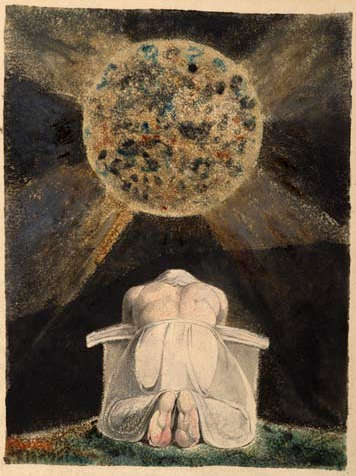
The archetype of the Creator is a familiar image in Blake's work.
Here, the demiurgic figure Urizen prays before the world he has forged.
(This work of art is in the public domain.)
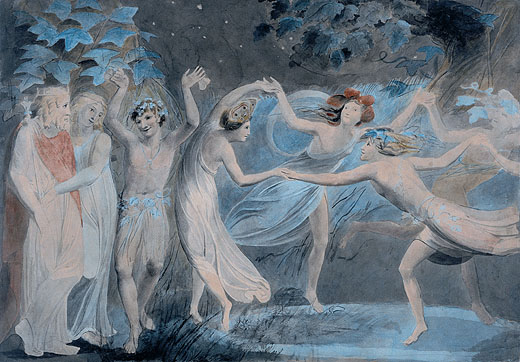
Oberon, Titania and Puck with Fairies Dancing by Blake, 1786
(This work of art is in the public domain.)
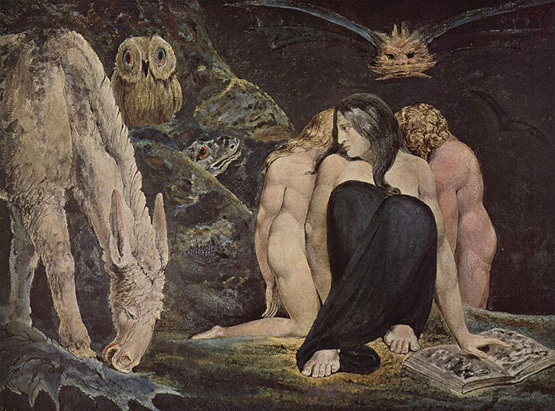
Hecate, 1795. Blake's vision of Hecate, Greek goddess of black magic and the underworld.
(This work of art is in the public domain.)
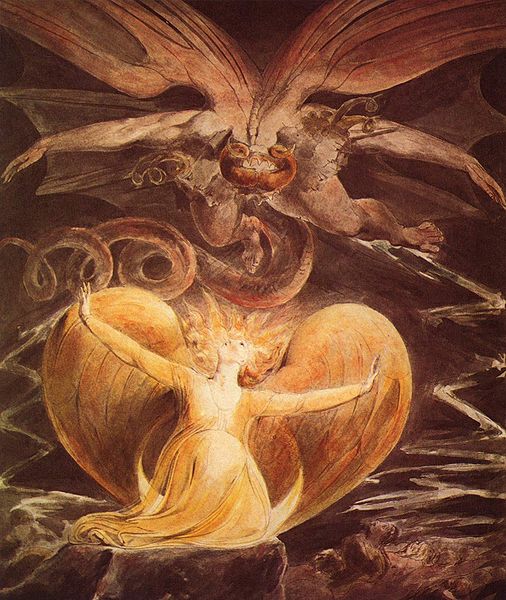
Blake's The Great Red Dragon and the Woman Clothed with Sun (1805) is
one of a series of illustrations of Revelation 12.
(This work of art is in the public domain.)
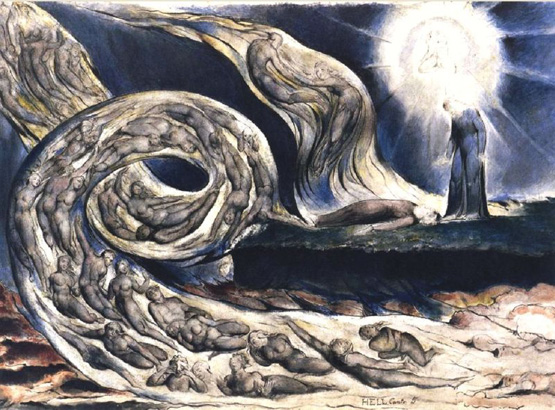
Blake's The Lovers' Whirlwind illustrates Hell in Canto V of Dante's Inferno.
(This work of art is in the public domain.)
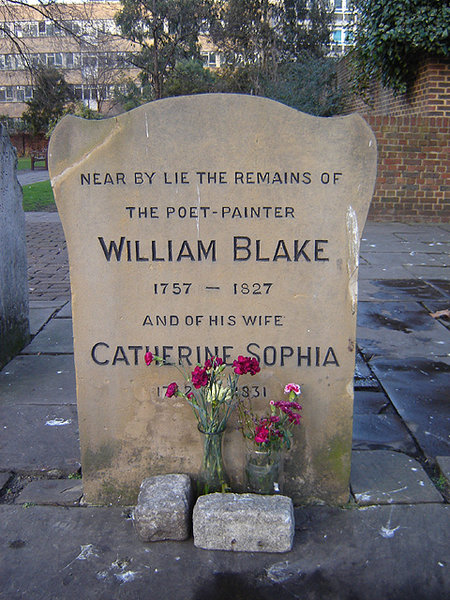
William Blake memorial, Bunhill Fields, City Road, Finsbury, London.
Photographer: Fin Fahey.
(Used under the Creative Commons Attribution ShareAlike 2.5 License)
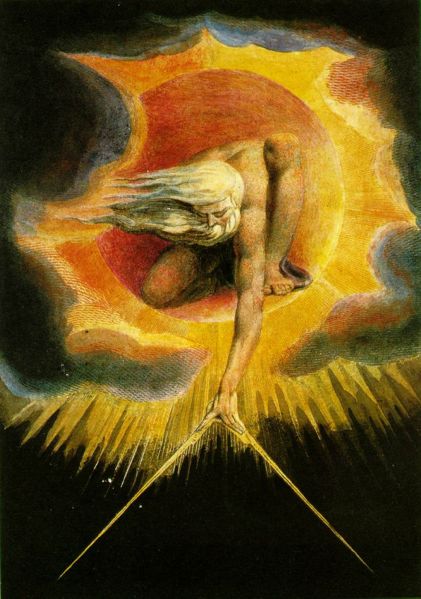
Blake's Ancient of Days. The "Ancient of Days" is described
in Chapter 7 of the Book of Daniel.
(This work of art is in the public domain.)
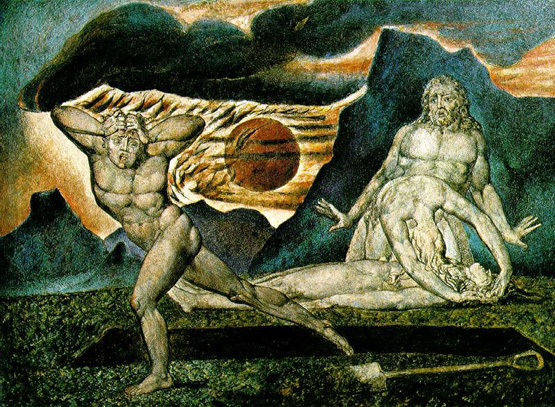
Blake's The Murder of Abel. The Body of Abel Found by Adam and Eve
(This work of art is in public domain.)
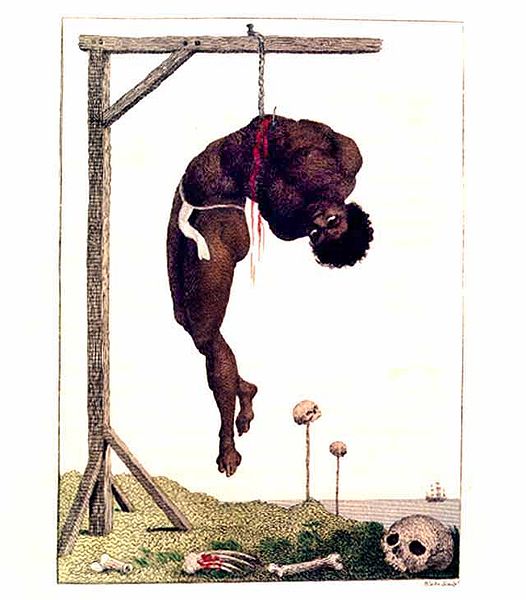
"A Negro Hung Alive by the Ribs to a Gallows" illustration by William Blake
for Captain John Stedman, 1796. Blake abhorred slavery and believed in racial and sexual equality.
(This work of art is in the public domain.)

Blake's Newton (1795) demonstrates his opposition to the "single-vision"
of scientific materialism.
(This work of art is in the public domain.)
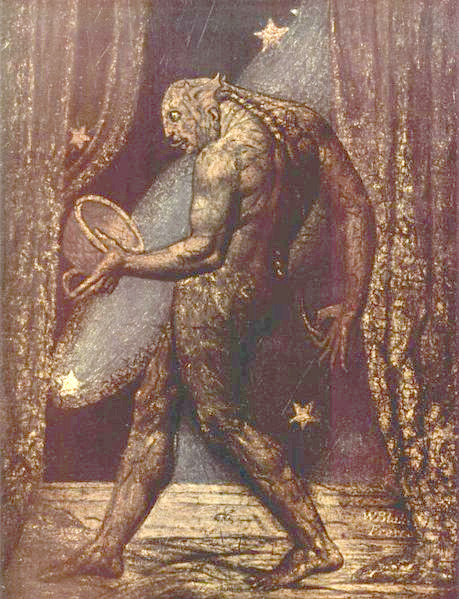
The Ghost of a Flea, 1819-1820, by William Blake. Fleas are often associated
with uncleanliness and degradation; in this work, Blake sought to magnify
a flea into "a monsterous creature whose bloodthirsty instinct was
imprinted on every detail of its appearance, with 'burning eyes which
long for moisture', and a 'face worthy of a murderer'."
(This work of art is in the public domain.)
  |
|





